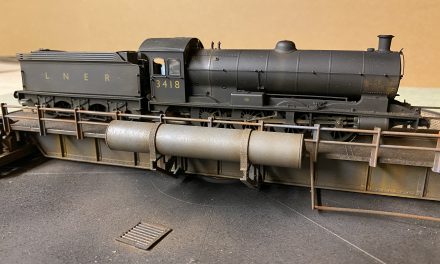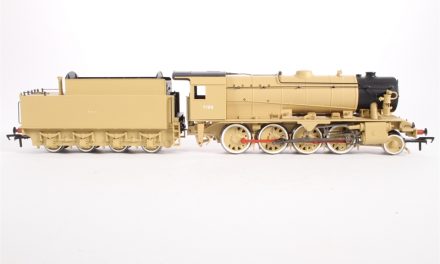One of my reasons for adopting DCC was my requirement for some degree of automation of the layout, so that it could be operated single handedly in as near a prototype fashion as possible where using traditional cab control would need several operators.
There is a pre requisite of automation; the DCC system needs to know where the trains are. I use the term DCC system in the widest sense, and this needs to comprise 3 elements; the DCC control unit; a feedback detection system; and a computer that is connected to the DCC control bus to provide the intelligence. My LENZ system provides both a feedback bus to which detectors can be connected and a computer interface to Xpressnet to allow a PC to be linked into the system. In my case I’m using JMRI Panelpro as the control system on the PC.
I’ve been wrestling with the physical means of detecting trains for some time, and the re seem to be 3 main options.There is almost no guidance available on the subject, so I wanted to share my thoughts on the subject just in case they are of some use to others. The main options appear to be:
- Block Occupancy detection requires the layout to be divided into individual blocks, each one isolated from the next, and the power to the block fed throgh the detector. The detector will sense any current being drawn by a train within the block
- Infra red detection relies on a sensor module that produces an infra red beam and is able to switch state when a train is above the beam and the beam is reflected back on the sensor.
- Magnetic detecion involves fixing magnets to the bottom of trains and these activating reed switches placed at strategic points on the track.
Needless to say there are pro’s and con’s of each, and I’m currently not convinced that a single method can meet the full requirement.
The key difference is that block detection provides constant detection of where the train is as it passes around the layout while the others only provide detection while the train is above the sensor.Most PC software seems to assume the existence of constant detection.
Block detection relies on detecting current being drawn from anywhere within the block and it will only report the block that the locomotive is in and ignore the rest of the train. This means that the train is recognised as soon as the locomotive enters a block, but the block becomes clear once the locomotive leaves, and not when the last car moves out of the block. The whole train can be detected if individual cars can all be made to draw current. Carriage lighting achieves this, as does the fitting of resistive wheelsets (metal wheels where a resistor is connected between the wheels to draw a small current). Of course if automation is to work successfully all trains must behave in the same way so if one train has carriage lighting others without this feature will need resistive wheels. While block detection will constantly report which blocks are occupied by trains it wont report the exact position of a train within the block and this makes triggering precise stopping difficult.
Magnetic detection will record the precise location of a train for stopping purposes as detection will only be triggered when the magnet under the train is directly on top of the reed switch. Magnetic detection is however incapable of detecting the whole train or providing continuous detection. The use of two detectors per block could enable sensing of a locomotive both entering and leaving a section, but not of the whole train clearing the section. One advantage, reed switches and magnets are very cheap, but it relies on every loco being fitted with a magnet and this might be a problem for visiting stock.
Infra red detection does detect the whole train, and a sensor at the start and end of each block could provide more accurate information than magnets. The disadvantage is the cost of these detectors at over £10 each. The use of 2 per block can soon get quite expensive. Of courseto save money the entry sensor for one block could be physically the same as the exit sensor from the previous one, and logic applied within the pc software keeping entry and exit detection separate. IR detection can also be made to provide continuous detection provided the space beween detectors is less than the length of the shortest train. In this way the train is always above at least one detector, but this increases the number of detectors needed and block size and position is dictated by train length and not appropriate start and finish of blocks for signalling purposes.
Infra red detection was my original method of choice. I’ve since changed my preference to block detection. The main driver is cost. The lenz system uses an LR101 module to link detection to the feedback bus. each LR101 can be fitted with 8 detectors. If an IR detector costs £10-£12 and an LR101 costs over £30 then the cost of detection adds up very quickly. Block detection using the Lenz system is equally expensive as Lenz block detectors also require attachment to the feedback bus via an LR101. Recently I discovered a module manufactured by an independent supplier but compatible with the Lenz system this combines 8 block detectors and a connection to the feedback bus on a single circuit for around £50 thus dispensing with the need for an LR101 and achieving detection for less than £7 per block.
I’m rapidly concluding that I probably need to adopt more than one method of detecion as there are points on the layout where I’ll need to trigger very precise stopping. I’ll use the infra red detectors to provide this (I have a number of IRDOT units already in stock awaiting fitting to the layout) and use the LDT RS-8-F modules for block detection. I’m currently revisiting the trackplan to determine the start and finish of each block before track is altered to provide isolation between blocks and power feeds are rerouted through the detectors.
Re wheeling rolling stock looks like its going to be a massive job, and currently I’m investigating how best to create resistive wheelsets. Current thinking is that as long as the front and back of every train can be sensed I dont need to bother with the stuff in the middle.







Hi,
Did you explore using RR&Co software prior to going down the JMRI route? I only ask as it is extremely well suited to meeting your brief of wanting to achieve prototypical operation. By this I mean full interlocking of points, block sections and signals, whilst running a complex timetable. The system can also be designed to allow for any number of human operators to work alongside the computer control, either acting as as drivers of locomotives, or signalmen.
I like your conclusion of using block sensors for detection, as again, this is more prototypical. You could also use very short block sections for accurate stopping of trains if you wished.
Hope the above is helpful
Best wishes
Mike
Mike
Thanks for the reply, I note what you say about RR & Co with interest, and yes I have thought about RR & Co, but its only in the last couple of months I’ve had a machine able to run it. As far as I’ve been able to tell RR & Co is windows only software and I’m a mac user for most stuff and the ancient pc in the railway room runs linux. JMRI has been my choice for ages as it runs happily on these machines and over the years Ive used more and more bits of it, for example it was the only package for quite a while that allowed the use of a mobile phone as a throttle. (I was involved in the user testing of WiThrottle before it was publicly available and have loved using it ever since the first day it arrived as a beta version on my iPhone)
I’ve heard of people giving up on JMRI and moving to RR&Co to achieve automation, but these folk always seem to refer to JMRI versions of several years ago and the software has developed hugely since then.
Now I have the ability to connect a windows pc to the layout I’ve taken another look, but so far I’ve been put off by the price, having preferred to spend available funds on decoders and detection devices. As far as I can see it doesn’t seem possible to try the software without buying it and there aren’t even any manuals available online to have a look at to get some idea of what it does. To do what I want seems to need at least the silver version (£300+), and since I can find no technical information I have no idea whether this will actually suffice or whether I’ll need the gold version (£500+).
The RR & Co website is shocking, obviously originally written in German and badly translated into English, and is a marketing exercise with virtually no technical information on the product, or at least none I’ve been able to find. So far this has put me off wanting to look any further, but hearing what you say about its capability I’ll keep an open mind. If you can point me to any manuals or the like I’d be very interested.
Re using short blocks for exact stopping, I had thought of that but I need to use the dozen or so Irdots I’ve bought to do something! ( I suppose I could always sell them on ebay to fund more block detectors)
Update……..
I’ve been back to th RR&co website and discovered that despite being listed in the price list as items to purchase, it is possible to download these for free. A quick look at the Bronze manual suggests the software will run without a license, so I’ll download a copy and have a play. The manual also shows some functionality available in bronze that I’d assumed from the limited info on the website would probably require silver.
Maybe this could be a lower cost venture than I had first assumed?